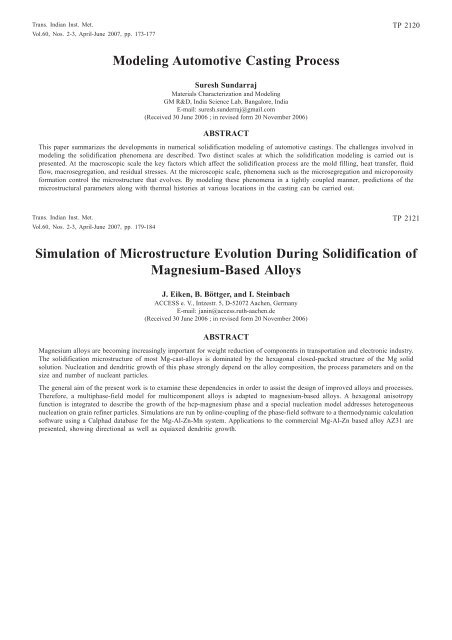Vol.60, Nos. 2-3 - Indira Gandhi Centre for Atomic Research
Vol.60, Nos. 2-3 - Indira Gandhi Centre for Atomic Research
Vol.60, Nos. 2-3 - Indira Gandhi Centre for Atomic Research
You also want an ePaper? Increase the reach of your titles
YUMPU automatically turns print PDFs into web optimized ePapers that Google loves.
Trans. Indian Inst. Met.<br />
<strong>Vol.60</strong>, <strong>Nos</strong>. 2-3, April-June 2007, pp. 173-177<br />
TP 2120<br />
Modeling Automotive Casting Process<br />
Suresh Sundarraj<br />
Materials Characterization and Modeling<br />
GM R&D, India Science Lab, Bangalore, India<br />
E-mail: suresh.sunderraj@gmail.com<br />
(Received 30 June 2006 ; in revised <strong>for</strong>m 20 November 2006)<br />
ABSTRACT<br />
This paper summarizes the developments in numerical solidification modeling of automotive castings. The challenges involved in<br />
modeling the solidification phenomena are described. Two distinct scales at which the solidification modeling is carried out is<br />
presented. At the macroscopic scale the key factors which affect the solidification process are the mold filling, heat transfer, fluid<br />
flow, macrosegregation, and residual stresses. At the microscopic scale, phenomena such as the microsegregation and microporosity<br />
<strong>for</strong>mation control the microstructure that evolves. By modeling these phenomena in a tightly coupled manner, predictions of the<br />
microstructural parameters along with thermal histories at various locations in the casting can be carried out.<br />
Trans. Indian Inst. Met.<br />
<strong>Vol.60</strong>, <strong>Nos</strong>. 2-3, April-June 2007, pp. 179-184<br />
TP 2121<br />
Simulation of Microstructure Evolution During Solidification of<br />
Magnesium-Based Alloys<br />
J. Eiken, B. Böttger, and I. Steinbach<br />
ACCESS e. V., Intzestr. 5, D-52072 Aachen, Germany<br />
E-mail: janin@access.ruth-aachen.de<br />
(Received 30 June 2006 ; in revised <strong>for</strong>m 20 November 2006)<br />
ABSTRACT<br />
Magnesium alloys are becoming increasingly important <strong>for</strong> weight reduction of components in transportation and electronic industry.<br />
The solidification microstructure of most Mg-cast-alloys is dominated by the hexagonal closed-packed structure of the Mg solid<br />
solution. Nucleation and dendritic growth of this phase strongly depend on the alloy composition, the process parameters and on the<br />
size and number of nucleant particles.<br />
The general aim of the present work is to examine these dependencies in order to assist the design of improved alloys and processes.<br />
There<strong>for</strong>e, a multiphase-field model <strong>for</strong> multicomponent alloys is adapted to magnesium-based alloys. A hexagonal anisotropy<br />
function is integrated to describe the growth of the hcp-magnesium phase and a special nucleation model addresses heterogeneous<br />
nucleation on grain refiner particles. Simulations are run by online-coupling of the phase-field software to a thermodynamic calculation<br />
software using a Calphad database <strong>for</strong> the Mg-Al-Zn-Mn system. Applications to the commercial Mg-Al-Zn based alloy AZ31 are<br />
presented, showing directional as well as equiaxed dendritic growth.
















